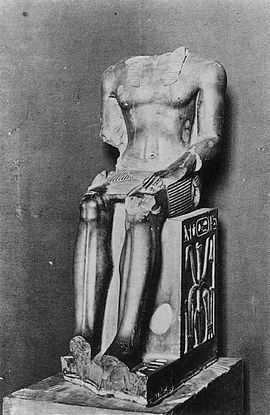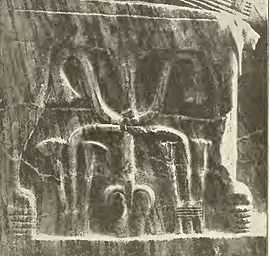
Chephren's seated statue.

Detail of Chephren's statue.
The
Union symbol (hieroglyph) is
Gardiner sign listed no. F36, part of the series for
parts of mammals. As a "union symbol", (a right and left half), it contains a vertical invisible 'centerline'. It allows for the positioning of two important hieroglyphs to be attached to it, right and left, as the
uniting of two halves; specifically this is referencing Upper Egypt (by the King of the South), represented by the sedge (hieroglyph),
and Lower Egypt (the King of the North), represented by the papyrus clump (hieroglyph)
.
In Egyptian hieroglyphs, the hieroglyph is used for the phonetic value of sma,[1] (a triliteral) with meanings of to join together, to unite with.[2]
For its use as
"uniting of two lands", it has an identical usage to the
Two whips with shen ring hieroglyph, which from its very construction appears as the uniting of two separate "tribes", or communities.
Palermo Stone usage
The Palermo Stone (also named: Royal Annals of the Old Kingdom of Ancient Egypt, of the previous ~700 years), scribed circa 2392 BC to 2280 BC, has two uses of the union symbol hieroglyph on the Palermo piece-(obverse) of the 7—piece Palermo Stone (one of the two large pieces). Both uses are for the symbol "ligatured" (tied) to the sedge hieroglyph and the papyrus clump hieroglyph, forming "one large symbol".
The symbols occur identically in Row II (of VI rows), and Row V; The difference between the two year-events, Row II identifies: Month 4, Day 13, and that is replaced in Row V with the Appearance of the King of the South, King of the North, in hieroglyphs:
The symbols as seen in Row V:[3] (1-vertical Year-register)
(The symbols are read in the "Gardiner font" left-to-right; the Palermo Stone is scribed opposite: right-to-left.)
Though Gardiner font hieroglyphs are read only left-to-right, interestingly, only one hieroglyph, the sedge (hieroglyph) is
non symmetric right, or left. Thus, the vertical hieroglyphs in Row II can be read correctly (left-to-right, and vertically down), with only the
sedge turned backwards, hieroglyph M16,
. (And the
circular scroll, no. F47,
comes in a right-or-left version, F46, or F47.)
Translated as: "Month 4, Day 13...." (Days 10 + 3) (Read right-to-left, Crescent moon (hieroglyph) on right, top.)

Ramesses II relief with union symbol hieroglyph.
See also
References
- Betrò, 1995. Hieroglyphics: The Writings of Ancient Egypt, Betrò, Maria Carmela, c. 1995, 1996-(English), Abbeville Press Publishers, New York, London, Paris (hardcover, ISBN 0-7892-0232-8)
- Budge, 1991. A Hieroglyphic Dictionary to the Book of the Dead, E.A.Wallace Budge, Dover edition, 1991; Original: c 1911 as: A Hieroglyphic Vocabulary to the Theban Recension of the Book of the Dead with an Index to All the English Equivalents of the Egyptian Words, (Kegan Paul, etc. Ltd, London, publisher). Dover: (softcover, ISBN 0-486-26724-5)
- Schulz, Seidel. Egypt: The World of the Pharaohs, Editors, Regine Schulz, Matthias Seidel, Könemann Verlagsgesellschaft mbH, Cologne, English translation version. (hardcover, ISBN 3-89508-913-3)


_1.jpg)
